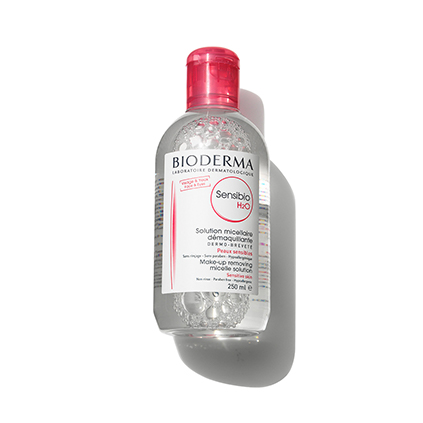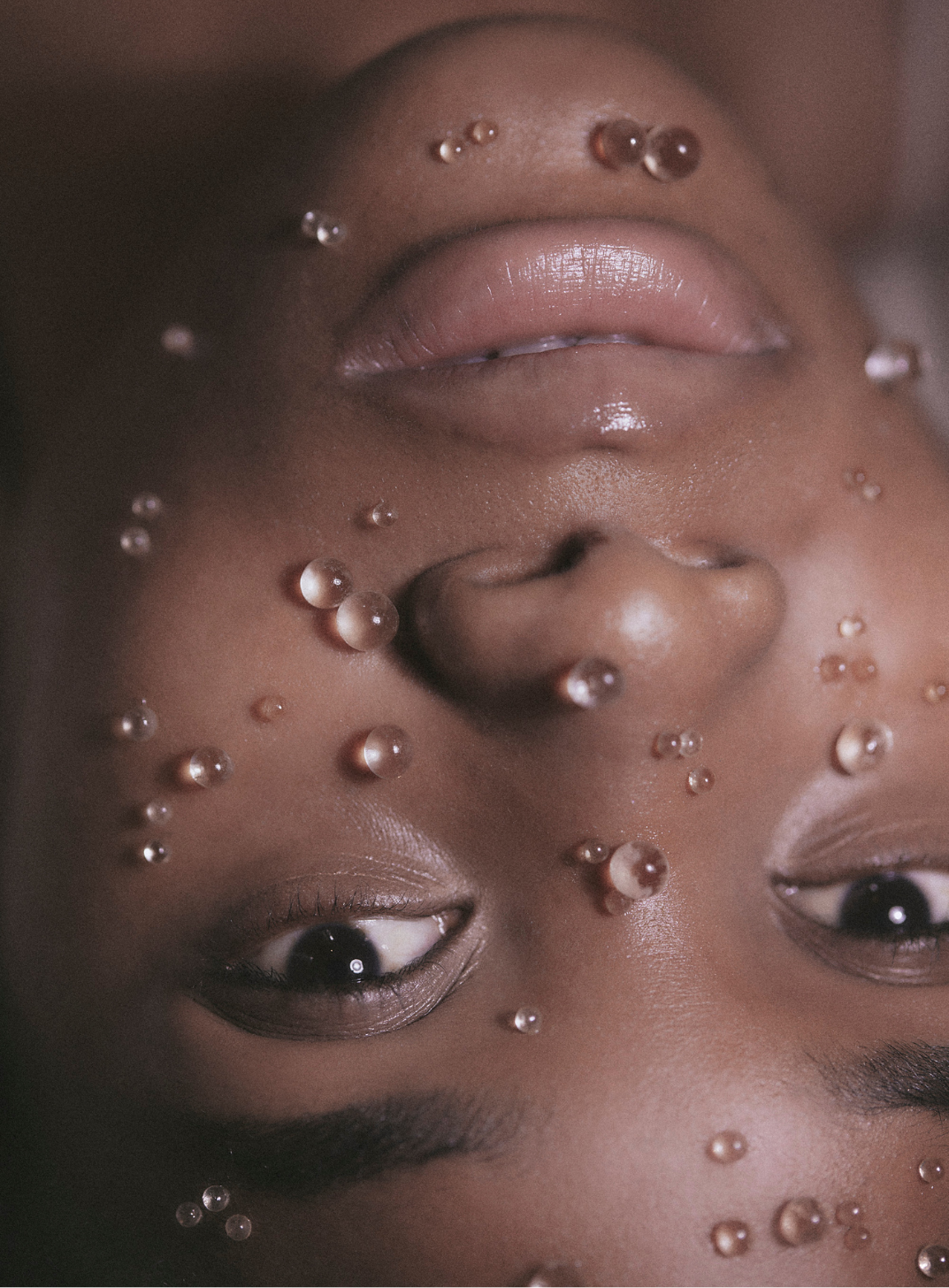The Skincare Routine That Got Rid Of My Hormonal Acne
I visited a dermatologist for an in-depth skin analysis and they changed everything.
Not to toot my own horn or anything, but my skin’s pretty brilliant right now. It’s smooth, it’s clear, it’s glowing. Rewind back a year and a half ago though, and things were a whole lot different.
Readers, I’d like you to meet my 2020 skin: dull, prone to blotchy areas of redness across my cheeks–my right cheek in particular, actually–and so darned hormonal. And when I say hormonal, I don’t mean that I get a single cute little spot once a month that I dab frosty white toothpaste over like a hair-swishing rom com heroine of the noughties. When I say hormonal, I mean that a collection of small little pimples bubble up around my jawline and mouth on the daily, and that things get particularly fruity and inflamed around my period. Nothing seems to keep them at bay. I’ve tried various forms of sulfur paste–that just makes them sore. Clay masks–these tone things down for an hour or so, but I’m looking for long-lasting results. Then there’s acid toners–I’ve got sensitive skin too (go figure) and extraction facials. Nada.
One week, mid-lockdown, I decided that enough was enough. My breakouts were so constant that my skin didn’t have time to heal. I’d suffered from mild acne in my teens and a course of antibiotics had sorted it out. I put in a call to my doctor, half expecting him to laugh me off the line. I was calling up mid-pandemic with a cosmetic request, after all. Within minutes though, he’d put me on a three-month course of Lymecycline–an antibiotic that works to kill spot-causing bacteria. First step, done.
Three months later, it had done the trick. As I popped the final pill I looked in the mirror. I had the odd scar that was yet to fade but otherwise my spots were gone. That’s when the fear sets in though, the worry that as soon as your body adjusts to a life without Lymecycline, the spots will return with a vengeance.
Luckily for me and my skin though, I had a derm appointment in the diary. Beauty editors are often gifted time with high profile dermatologists, and on this occasion I was visiting Dr Stefanie Williams, dermatologist and medical director of London’s Eudelo Dermatology & Skin Wellbeing Clinic. After mere minutes in her chair and under her microscope, she had prescribed me a detailed skincare routine that would both keep my breakouts at bay and calm the rosacea she had diagnosed across my cheeks. The best bit? Zero antibiotics required.
The Routine
Morning
- Cleanse – I use a gentle cleanser, Bioderma’s Sensibio H20 Micellaire or CeraVe’s Foaming Cleanser, and Dr Williams OK’d both. They’re both fragrance-free.
- Serum – I apply a few drops of SkinCeuticals Serum 10 AOC Vitamin C Serum, a sensitive-skin-friendly vitamin C serum that offers environmental protection.
- Prescription Cream – Dr Williams prescribed me a tube of Rosex 0.75% Gel and advised me to smooth a thin layer over my face each morning. It’s an antibiotic cream that targets the inflammation and small whiteheads usually associated with rosacea.
- Moisturise – Though the Rosex feels quite nourishing in itself, Dr Williams said that I might still need a moisturiser and advised me to apply SkinCeuticals Redness Neutralizer Gel Cream to further tone down the blush that comes with rosacea.
- SPF – Finally a non-negotiable, a broad spectrum sunscreen. Dr Williams recommended SkinCeuticals again and their Ultra Facial Defense Sunscreen SPF50. It’s lightweight, comfortable and doesn’t clog pores.
Evening
- Cleanse – I double cleanse, wiping off makeup with my micellar water and rinsing with my CeraVe Foaming Cleanser.
- Prescription Cream – A different one this time. Dr Williams prescribed me a tube of Finacea 15% Gel, a topical treatment for mild to moderate acne. It’s made with azelaic acid–a wonder ingredient that tempers excess sebum and kills the bacteria that causes acne. I’ve heard countless dermatologists sing azelaic acid’s praises.
- Moisturiser – I kept to my usual, Decree’s Peptide Emollient Veil. It’s a lightweight daily moisturiser made with hyaluronic acid–each molecule of which can hold on to up to one thousand times its weight in moisture–and antioxidant-rich resveratrol, which works to reduce hyperpigmentation.
“I’ve barely experienced a spot since.”
I followed the routine to the letter for a year and a half and I’m deliriously happy to report that I’ve barely experienced a single spot since. That’s no exaggeration either, not even a monthly rom-com-worthy one. While no two people’s skin ailments or cure-alls are ever likely to be the same, my experience does prove the worth of a good dermatologist. If your skin quirks lack rhyme or reason and they’re getting you down, book in an appointment. If hormonal acne is your bugbear, ask your doctor about a prescription azelaic acid cream. Moral of the story? Professional advice is priceless.
Photography: Charlotte Coquelin
The Skincare Routine That Got Rid Of My Hormonal Acne
I visited a dermatologist for an in-depth skin analysis and they changed everything.
Not to toot my own horn or anything, but my skin’s pretty brilliant right now. It’s smooth, it’s clear, it’s glowing. Rewind back a year and a half ago though, and things were a whole lot different.
Readers, I’d like you to meet my 2020 skin: dull, prone to blotchy areas of redness across my cheeks–my right cheek in particular, actually–and so darned hormonal. And when I say hormonal, I don’t mean that I get a single cute little spot once a month that I dab frosty white toothpaste over like a hair-swishing rom com heroine of the noughties. When I say hormonal, I mean that a collection of small little pimples bubble up around my jawline and mouth on the daily, and that things get particularly fruity and inflamed around my period. Nothing seems to keep them at bay. I’ve tried various forms of sulfur paste–that just makes them sore. Clay masks–these tone things down for an hour or so, but I’m looking for long-lasting results. Then there’s acid toners–I’ve got sensitive skin too (go figure) and extraction facials. Nada.
One week, mid-lockdown, I decided that enough was enough. My breakouts were so constant that my skin didn’t have time to heal. I’d suffered from mild acne in my teens and a course of antibiotics had sorted it out. I put in a call to my doctor, half expecting him to laugh me off the line. I was calling up mid-pandemic with a cosmetic request, after all. Within minutes though, he’d put me on a three-month course of Lymecycline–an antibiotic that works to kill spot-causing bacteria. First step, done.
Three months later, it had done the trick. As I popped the final pill I looked in the mirror. I had the odd scar that was yet to fade but otherwise my spots were gone. That’s when the fear sets in though, the worry that as soon as your body adjusts to a life without Lymecycline, the spots will return with a vengeance.
Luckily for me and my skin though, I had a derm appointment in the diary. Beauty editors are often gifted time with high profile dermatologists, and on this occasion I was visiting Dr Stefanie Williams, dermatologist and medical director of London’s Eudelo Dermatology & Skin Wellbeing Clinic. After mere minutes in her chair and under her microscope, she had prescribed me a detailed skincare routine that would both keep my breakouts at bay and calm the rosacea she had diagnosed across my cheeks. The best bit? Zero antibiotics required.
The Routine
Morning
- Cleanse – I use a gentle cleanser, Bioderma’s Sensibio H20 Micellaire or CeraVe’s Foaming Cleanser, and Dr Williams OK’d both. They’re both fragrance-free.
- Serum – I apply a few drops of SkinCeuticals Serum 10 AOC Vitamin C Serum, a sensitive-skin-friendly vitamin C serum that offers environmental protection.
- Prescription Cream – Dr Williams prescribed me a tube of Rosex 0.75% Gel and advised me to smooth a thin layer over my face each morning. It’s an antibiotic cream that targets the inflammation and small whiteheads usually associated with rosacea.
- Moisturise – Though the Rosex feels quite nourishing in itself, Dr Williams said that I might still need a moisturiser and advised me to apply SkinCeuticals Redness Neutralizer Gel Cream to further tone down the blush that comes with rosacea.
- SPF – Finally a non-negotiable, a broad spectrum sunscreen. Dr Williams recommended SkinCeuticals again and their Ultra Facial Defense Sunscreen SPF50. It’s lightweight, comfortable and doesn’t clog pores.
Evening
- Cleanse – I double cleanse, wiping off makeup with my micellar water and rinsing with my CeraVe Foaming Cleanser.
- Prescription Cream – A different one this time. Dr Williams prescribed me a tube of Finacea 15% Gel, a topical treatment for mild to moderate acne. It’s made with azelaic acid–a wonder ingredient that tempers excess sebum and kills the bacteria that causes acne. I’ve heard countless dermatologists sing azelaic acid’s praises.
- Moisturiser – I kept to my usual, Decree’s Peptide Emollient Veil. It’s a lightweight daily moisturiser made with hyaluronic acid–each molecule of which can hold on to up to one thousand times its weight in moisture–and antioxidant-rich resveratrol, which works to reduce hyperpigmentation.
Photography: Charlotte Coquelin
“I’ve barely experienced a spot since.”
I followed the routine to the letter for a year and a half and I’m deliriously happy to report that I’ve barely experienced a single spot since. That’s no exaggeration either, not even a monthly rom-com-worthy one. While no two people’s skin ailments or cure-alls are ever likely to be the same, my experience does prove the worth of a good dermatologist. If your skin quirks lack rhyme or reason and they’re getting you down, book in an appointment. If hormonal acne is your bugbear, ask your doctor about a prescription azelaic acid cream. Moral of the story? Professional advice is priceless.
















Comments